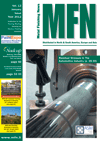E-Archive
Nadcap Column
in Vol. 13 - January Issue - Year 2012
Murphy’s Law Misunderstood? That’s Just Typical!
Murphy’s Law is widely believed to be a law based on pessimism. "Anything that can go wrong, will go wrong" does sound like it came from someone who always saw the worst in life.
However, it is important to recognise that this may not be a negative attitude, but that of a person dedicated to Quality. Murphy’s Law may actually be a statement that goes to the very heart of the pursuit of excellence.
Major Edward A. Murphy was an engineer in the U.S. Air Force from 1940-1952 where he worked on some of the most experimental airplanes of the 20th century, including the XB-70 Valkyrie and the SR-71 Blackbird. However, he is most famous for the creation of one of life’s certainties, that being "anything that can go wrong, will go wrong".
The phrase was coined in 1949 while working on the Air Force Project MX981, which was designed to test how much sudden deceleration a person could withstand in a crash. Murphy found that a transducer had been wired incorrectly and later when he heard who the technician responsible for the error was, complained, "If there is any way to do it wrong, he’ll find it". It is believed that the project manager who ran this project kept a list of rules and added this to it, naming it Murphy’s Law. Later Dr John P Stapp, who rode the sled on the deceleration track pulling up to 40 Gs, said in a press conference, that the good safety record on the project was due to a firm belief in Murphy’s law and the necessity to circumvent it.
The term was used by aerospace companies who aired it in their adverts over the following few months. It was then picked up by the media and Murphy’s Law moved into everyday language. Murphy was reportedly unhappy with this common misinterpretation of his law. What he was in fact trying to do was crystallise a key principle of defensive design: that one should always assume the worst-case scenario when designing objects, to minimise human error.
This is now commonly referred to as "mistake proofing" and can be seen in designs from the three-pin plug to circuit breakers to envelopes with windows and ensuring that the mail intended for one person cannot be sent to another.
This requires a preparedness to embrace change. Suppose you came upon a man in the woods, working to saw down a tree. He is exhausted from working for hours. You suggest he could take a break to sharpen the saw, as it will help the work go faster. He replies "I don’t have time to sharpen the saw! I’m busy sawing!"
People who don’t take time out to "sharpen the saw" – to take a step back and review the way they work – may not be well placed to deal with change when it occurs. Indeed, Abraham Lincoln famously said, "Give me six hours to chop down a tree and I will spend the first four sharpening the axe."
This is really about working "smarter, not harder". For busy companies, asking a simple question focused on different business elements will help to stimulate ideas and anticipate change. For example, what if... a member of staff leaves the company? Having an interim plan in place to handle their workload, and a succession plan to deal with the situation more permanently, will help the company react to the change without disrupting productivity. Or what if… sales drop? There needs to be robust financial contingencies in place to ensure that the company can continue to operate efficiently and effectively in the short-term to allow time to consider the next steps for the ongoing stability of the business.
Limiting the opportunity for human error is a fundamental part of the pursuit for excellence. Keeping in mind the true meaning of the saying "anything that can go wrong, will go wrong" is a good start.
Learn more at www.pri-network.org, or contact Joanna Leigh joanna.leigh@pri-europe.org.uk




























